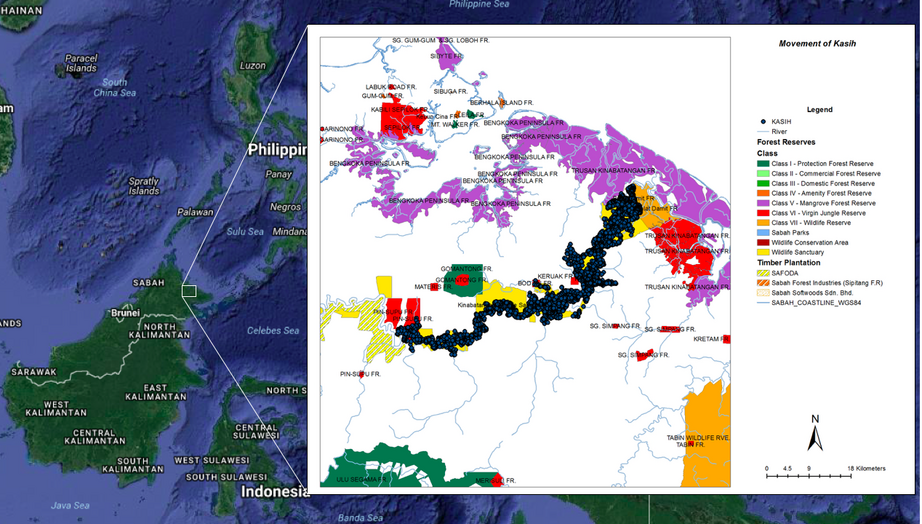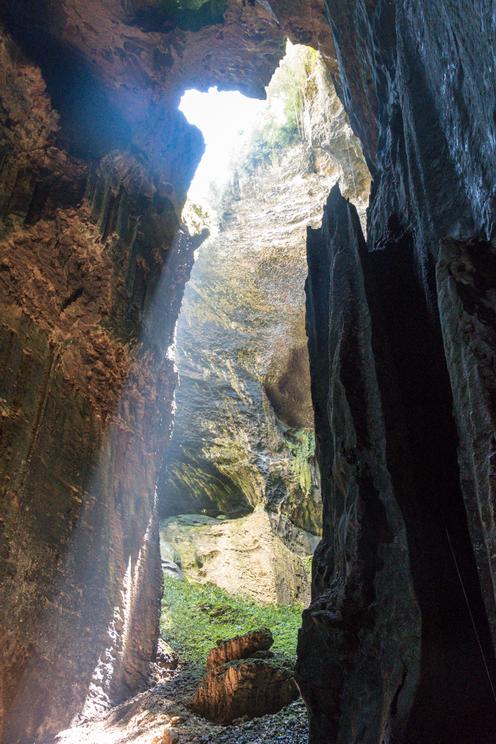Over the bridge: the battle for the future of the Kinabatangan
The bridge across the Kinabatangan River and through a wildlife sanctuary has been cancelled, succumbing to pressure from local and international conservation groups. But questions remain about the future of the area.
- Proponents of the project contend that a bridge and associated paved road to Sukau would have helped the town grow and improve the standard of living for its residents.
- Environmental groups argue that the region’s unrealized potential for high-end nature tourism could bring similar economic benefits without disturbing local populations of elephants, orangutans and other struggling wildlife.
- The mid-April cancellation of the bridge was heralded as a success for rainforest conservation, but bigger questions loom about the future of local communities, the sanctuary and its wildlife.
SUKAU, Malaysia – At first blush, the muddy waters of the Kinabatangan River in northern Borneo seem to laze through a hodge-podge of sleepy fishing and farming villages. The river winds past oil palm plantations pushing right up to the river’s edge, crumbling (and striking) limestone cliffs, and abutting explosions of vegetation extending from carpets of hyacinth (Hyacinthus spp.) – introduced by a British colonist who liked the way they looked, according to local lore – to the twisting lianas and the tops of the tall trees standing guard on the river bank.
But like most rainforests, the stillness along Malaysia’s second-longest river belies what is in fact a dynamic and ever-changing place.
The Kinabatangan and the narrow wildlife sanctuary named for it, pinned to its banks by thousands of hectares of oil palm on all sides, have recently pulled the state of Sabah into the spotlight, as the opposition from local and international conservation groups to a planned bridge in the town of Sukau across the river has grown.
The bridge was cancelled in mid-April, according to a speech by Sabah’s chief conservator of forests, Sam Mannan. But Saddi Abdul Rahman, Sukau’s representative to the Sabah State Legislative Assembly, hasn’t given up on the project yet, and said in a message to Mongabay that he will wait until he has official confirmation from the state’s chief minister.

The inset map shows the movements of Kasih, a Bornean pygmy elephant, throughout the Lower Kinabatangan Wildlife Sanctuary over several years. Inset map courtesy of Benoit Goossens/Danau Girang Field Centre. Base map courtesy of Google Earth.
Finding a road to development
The Sukau bridge was a piece of the 2008 Sabah Development Corridor, a statewide plan set in motion to boost Sabah’s economy. Saddi has argued in the press that the 350-meter (1,148-foot) bridge and associated paving of an existing dirt-and-gravel road would connect communities east and south of the Kinabatangan River with the town of Sukau on the river’s western bank, providing them with access to markets and services like healthcare.
Currently, the infrequent Morisem Ferry links the two sides of the river. Saddi and others have said the bridge and paved road are necessary for the economic development of Sukau. Community members have reportedly voiced their desire to turn their town into a hub that connects far-flung areas in northern Borneo with the larger towns of Lahad Datu and Sandakan.
But conservation groups and scientists working in the area have waged a long battle against the bridge, arguing that it would lead to the destruction of the habitats now protected in the wildlife sanctuary. They warned that the ecotourism possibilities just beginning to take root in the area – and an associated economic boom – could wash away if the project had been allowed to move forward.
The move to nix the plans drew immediate praise from the bridge’s opponents when Mannan shared the news at an event for the South East Asia Rainforest Research Partnership on April 18.
“When Datuk Sam Mannan made the announcement that the bridge plan had been cancelled at the Royal Society of London, an international audience of conservationists, scientists, business people, entertainers, and philanthropists erupted in applause,” said Greg Asner, a global ecologist at the Carnegie Airborne Observatory, whose team has been working on mapping the carbon stocks and biodiversity of Sabah.
“It was a great, and rare, moment for rainforest conservation,” Asner said in an email to Mongabay.
It’s a moment that might not have happened without significant opposition to the project from outside Borneo and Malaysia. British naturalist David Attenborough voiced his concerns for the Lower Kinabatangan Wildlife Refuge’s diverse wildlife in an article published in The Guardian newspaper in March.
“If I may say so, that headline broke the camel’s back,” Mannan said, according to a statement from the Sabah Forestry Department. Attenborough’s denunciation of the project “made us understand that the issue of a proposed bridge across a protected area for wildlife, is now the number one environmental concern not just in Sabah, but globally too, because of the extremely precarious situation of the rich wildlife therein.”

A rhinoceros hornbill (Buceros rhinoceros) along the Kinabatangan River. Photo by John C. Cannon
Biologist Benoit Goossens made that same point when I met with him in his Kota Kinabalu office at the Sabah Wildlife Department in early April, a week and a half before the state government shut down the project.
“It would be an ecological disaster,” he said. Goossens directs the Danau Girang Field Center, located in Lot 6 of the sanctuary and jointly run by the Sabah Wildlife Department and Cardiff University in Wales.
Pulling out a map, he traced his fingers over hundreds of blue dots, each representing a ping from a satellite tracking collar on an elephant named Kasih. Over the course of several years, the spots trace her movement upstream and downstream from the town of Sukau on both sides of the river.
Kasih, a representative of the smallest subspecies of the IUCN-listed Endangered Asian elephant, the Borneo pygmy elephant (Elephas maximus borneensis), avoided much of the ocean of pale green on the map, which represents the land devoted to oil palm. Instead, she stuck mostly to the patches of yellow and red, representing the wildlife reserve boundaries, and the pink Mangrove forest reserves where the Kinabatangan splays out and feeds the sprawling Kinabatangan-Segama Wetlands before emptying into the Sulu Sea. The wetlands were designated a Ramsar Site because of the peat forests and mangroves they contain and the range of endangered species found there.
On the map, a tight cluster of blue circles in a narrow arm of the wildlife sanctuary called Lot 3 that juts eastward from the river then extends northward identifies an area Kasih seems to favor. It’s also right where a narrow splinter of road currently exists. If the bridge and road were built, this stretch would have been turned into a massive bridge over the sanctuary called a flyover roughly 1,300 meters (0.81 miles) in length, in theory maintaining the connectivity of the wildlife habitat on either side.
“They think the elephants will just pass,” Goossens said. But Goossens has little faith that the flyover would allow the sanctuary’s 250 elephants to pass freely, pointing out again how much the oil palm plantations have constricted Kasih’s movement.
He said this kind of development would just force an already densely packed population of elephants into even tighter quarters, inevitably leading to conflict between the elephants and the people as they both vie to make use of limited space in the area.

Borean pygmy elephants (Elephas maximus borneensis) are the smallest subspecies of the Asian Elephant. Photo courtesy of Marc Ancrenaz/HUTAN
People or wildlife?
Saddi said that views such as Goossens’ don’t take the needs of the Sabahans he represents into account.
“Twenty-six thousand hectares have been designated for wildlife conservation,” Saddi said in comments recorded by The Borneo Post on April 12. “Isn’t it enough for wildlife? Some belong to the people too.”
In an exchange by text message, he said the project would connect Sukau by road to Sabah’s east and west coasts, improve the standard of living for the town’s population and help the town’s economy to grow.
“The bridge [and] road could change the whole landscape of Sukau,” he said, adding that their construction had been approved by the state and federal governments in 2015.
Goossens’ argument is that Sukau is already well-connected by road to Lahad Datu and Sandakan, and the residents of the villages on the other bank of the river would be better off taking the existing Jericho Road.
“We have been asking people whether they would use this bridge to go to Sukau or go to the clinic,” he said. “They said, ‘No, it’s faster for us to go to Lahad Datu.’”
Goossens instead advocates a plan to invest money in health clinics in the villages, giving residents better access to healthcare and eliminating the need to travel to Sukau’s clinic.
“I’m thinking about the people,” he said.
There’s little doubt on either side of the argument that development plans such as the bridge and the attached highway would only serve as an attraction for more people to move into the area. Those people will need space to build their homes and to farm. But land is currently in short supply, and a worry from the conservation community is that any new settlements will come at the expense of wildlife habitat.
As tropical ecologist Bill Laurance puts it, “If you want to predict where on the Earth deforestation’s going to be, map the roads.”
Laurance and his team from James Cook University in Cairns, Australia, recently traveled to Malaysia and Indonesia to introduce their new initiative to map out infrastructure projects. Their aim is to provide planners selecting the sites for roads and other development projects with the best data available to maximize social and economic benefits and minimize environmental footprints. On their visit, they met with government officials, NGOs and other scientists in Borneo and Peninsular Malaysia and sought partnerships to identify these projects before they get going.
Laurance’s research involving “cold, hard, cost-benefit analyses” has shown that just constructing a road to every village won’t produce the greatest returns.
“One of the least-cost-effective ways to manage infrastructure is to try to connect all these remote areas,” Laurance said in a discussion with a Malaysian town planner in Sabah. “You’re much better off connecting the largest number of people.”
Laurance calls for identifying areas of high ecological importance and steering infrastructure projects away from them to more populated, and thus more economically beneficial, areas.

A mother proboscis monkey (Nasalis larvatus) jumps from tree to tree with baby in tow in the Lower Kinabatangan Wildlife Sanctuary. Photo by John C. Cannon
Scientists who know the Kinabatangan said that the ecological costs of this type of development would be too high.
“The bridge presented significant challenges to numerous rainforest species, so the conservation and science communities had been raising awareness of the problems associated with the bridge construction,” Asner said.
According to Mannan, their views held a lot of sway with Chief Minister Musa Aman.
“The chief minister of Sabah has taken everyone’s views into consideration – including Sir David [Attenborough]’s – before deciding on this very important issue,” Mannan said in the forestry department statement, “and I am pleased to say that balanced development has prevailed.”
“This is another very positive move by Sabah’s Chief Minister to protect remaining forests in Sabah,” Asner said.
The river’s riches
Along the Kinabatangan River, signs of elephants aren’t hard to find, though the animals themselves can be a bit tougher to track down. Much of the other wildlife is not. One of the lodges offering boat safaris on the river promises a free night cruise if you don’t see a proboscis monkey (Nasalis larvatus), listed as Endangered by the IUCN, on your first boat trip. Spoiler alert: You will see them.
I joined veterinarian-turned-wildlife biologist Marc Ancrenaz as he made the rounds to check on the various projects of the organization he directs and co-founded, HUTAN. Two of the group’s staffers joined us on the boat.
Though they originally targeted orangutans, HUTAN has since branched into broader conservation work. We head downstream to check on a new electric fence just installed to protect a reforestation project. The fence is a temporary barrier that crews will remove in a few years, once the trees can withstand the landscaping predilections of the elephants. But for now, HUTAN staff must nurture the forest back to life.
On our way, we catch the team returning to Sukau. Clad in wide-brimmed hats and long sleeves, they’re all smiles after a hard day’s work clearing out the vegetation from the budding forest floor so it doesn’t choke out their saplings. They’re also almost all women.
“They develop a relationship with the plants,” Ancrenaz says, and as a result, more of the trees they plant survive than when they’re planted by crews of men. While the men who worked on HUTAN’s early reforestation projects could take the long hours of back-bending work, the forest just didn’t come back.
“It was a complete failure,” Ancrenaz says.
[image id=60762]
A long-tailed macaque (Macaca fascicularis) in Gomantong Forest Reserve, which connects to the Lower Kinabatangan Wildlife Sanctuary. Photo by John C. Cannon
At the site, we step off the boat into a shaded clearing with a few awnings stretched between tree trunks to make a rest area for the workers. Right in the middle sits a fresh pile of elephant dung, and a few steps past, toward the electric fence, we find dinner-plate-size footprints in the wet mud.
Creating these corridors along the river will fight erosion, improve water quality and provide a path for elephants and other animals so they can avoid the oil palm plantations just beyond where we now stand. Throughout the wildlife sanctuary, connectivity between the patchwork of protected lands near the Kinabatangan remains a huge problem.
The river itself is perhaps the most striking – and perhaps fleeting – symbol of the importance of connectivity. Ancrenaz explains that the stretch between where we now stand and the Sulu Sea represents Sabah’s last rainforest-to-mangrove gradient. It’s particularly important because scientists predict that as the climate changes, the animals that inhabit the Kinabatangan-Segama Wetlands downstream will seek refuge in the rainforest further upstream. If that rainforest is gone, or there’s a break in the chain of viable habitat, countless species will have nowhere to go.
A Vision for the future

Gomantong Cave, located near the Kinabatangan River, is home to millions of bats and swallows, which produce the valuable nests that go into bird’s nest soup. Photo by John C. Cannon
Later on, our position sitting low on the water provides a perfect vantage point for the unfolding drama around us.
The three men in the boat have effectively become my eyes into the forest’s secrets. They’re adept at picking out shapes among the dark shadows near the tops of the trees in ways that would take me years to learn. From impossibly far distances, they pick out bickering macaques and proboscis monkeys bouncing from branch to branch or the hornbills zigzagging back and forth over the wider stretches of the Kinabatangan.
For many conservationists, protecting the Kinabatangan as an ecotourism destination is a priority, arguing that it will pump money into the local economy and create jobs. Even with the handful of premium lodges that have sprung up and the numerous homestays with members of the local communities available to tourists, it still seems that the tourism potential of the region is largely untapped.
They feared a bridge would further carve up habitat for elephants, orangutans and proboscis monkeys already on the decline. And they argued that these forests thread a needle in providing for both people and wildlife – at least for now.
Visitors would also benefit from its unique situation, proponents of enhanced ecotourism say. The Lower Kinabatangan Wildlife Sanctuary combines accessibility with swarms of wildlife like few places on Earth. Lahad Datu and Sandakan each have multiple daily commercial flights connecting them to Kota Kinabalu, Sabah’s largest city, so the pro-tourism camp sees Sukau becoming a base for eager birdwatchers and bucket-list wildlife watchers looking for a porthole into life in the jungle. They also assert that the town could capitalize on the growth and development many of the bridge’s backers sought in the first place.
A group of local and international NGOs put together a detailed proposal outlining a long-term vision for the Kinabatangan “corridor of life,” which includes the wildlife sanctuary and a handful of other protected connected protected areas, such as the forest where the famous Gomantong Cave is located. They delivered it to Sabah’s chief minister on April 7. While it makes no specific references to the Sukau bridge project, it does call for “No new road bridges” crossing the river.
The “Save Kinabatangan” report lays out four pages of goals for the area, ranging from more responsible production of oil palm, greater connectivity of habitats, and restoration of degraded lands. But what anchors the plan is development of the unrealized potential of bringing outsiders to see this area and “making the Kinabatangan a top ecotourism destination in South East Asia,” which won’t happen unless these forests and the animals that inhabit them remain intact.
“We need to reinforce the importance of the Kinabatangan as an ecological site, as a touristic site, and try to find the best ways to manage this protected area,” Goossens said.

A limestone cliff on the Kinabatangan River near the town of Sukau. Photo by John C. Cannon
International opposition
At the same time, Saddi and other proponents of the bridge project have emphasized that the greatest support for the bridge project appears to have come from the community of Sukau, and the resistance to it from the outside.
The organizations and people involved, including HUTAN, Land Empowerment Animals People (LEAP), and WWF-Malaysia, counter that they represent many decades of working side by side with community members in the name of conservation. Danau Girang Field Center is also a member of the Save Kinabatangan coalition, and Goossens has worked in Sabah for 17 years.
Like Goossens, many of those involved, if not Sabahan themselves, call Malaysian Borneo home and express demonstrable love and affection for the land, its natural treasures and the people who live here. They argue that the organizations they represent employ local people and help them develop marketable skills, and most have projects aimed improving the quality of life for local communities.
In fact, Ancrenaz points out that coming in as an outsider will likely only lead to failure and frustration – a lesson he had to learn.
“All of your education, all of these things, you just have to put them aside and sit down and listen,” Ancrenaz said.
Before he began working in Sabah, his focus was on the wildlife, whether he was working with gorillas in Gabon or reintroducing oryx in Saudi Arabia. “I did not understand that conservation is not about animals,” he said. “It is all about people.
“If you don’t work together with wildlife conservation and communities, it will not work.”
And yet the effort to stop a development seen as dangerous for conservation in Sabah has succeeded largely through what critics have decried as a top-down strategy, in which people who weren’t born in Sukau convinced the chief minister of Sabah to cancel a project in the town from his office in Kota Kinabalu. Whether this “great, and rare, moment for conservation” will persist and the Kinabatangan stays a robust natural refuge remains to be seen, and there’s little doubt that the swing of the pendulum will depend on how engaged the local community becomes in its protection.

An oriental pied hornbill (Anthracoceros albirostris) takes flight along the Kinabatangan River. Photo by John C. Cannon
The next morning on the Kinabatangan, we’re slicing through ever-denser sections of forest, providing a cross-sectional view of a forest brimful with life. Soon, the canopy opens wide again, and we glide into an oxbow. The driver cuts the engine, enjoying a few cool moments before the sun burns off the last tendrils of fog. I reflect on this window into the life of the rainforest. So many of the world’s tropical forests lie out of reach, and here I sit, in the middle of one, an easy car ride from a city and mere minutes from a comfortable bed in the lodges or homestay houses along the banks of the Kinabatangan.
I’m caught staring inanely at a bushy-crested hornbill (Anorrhinus galeritus) that’s just tucked in behind some branches, as my companions whisper to get my attention. A saltwater crocodile (Crocodylus porosus) has just risen, and I turn to see a jagged hump trailing a yellow-eyed snout take a diffident patrol around us. The full extent of its tail leaves little doubt about the size of the animal, which can reach 7 meters (23 feet). Or that the connection with sea, more than 60 kilometers (37 miles) downstream, remains intact for now.
A boat from one of the tourist lodges rounds the far bend of the oxbow, too far to see the crocodile. Unperturbed, it slips beneath the water without breaking the surface tension. Orange-life-preserver-clad tourists fill the approaching boat, and, like me, they’re slinging binoculars and cameras around at anything that looks interesting with wide grins on their faces. Their guide cuts their motor as well. Minutes later, I hear shrieks of delight and see fingers pointing toward the canopy.
Are we sitting in the midst of progress toward a solution like that crafted in the Save Kinabatangan proposal, one where these tourists and I are just a few of many who will come and get to see a rainforest in Borneo up close?
The darker picture, from a conservation perspective, is that we are indeed seeing progress unfold. Only in this reality, we’re the trailing edge of a lucky few visitors who got to see the last gasps of the Kinabatangan, before the elephants and monkeys and orangutans and clouded leopards fade into what once was and give way to a world that looks much more like the one we come from.
Bridge or no bridge, there’s little doubt that the Kinabatangan and all its life sit at a crossroads.

